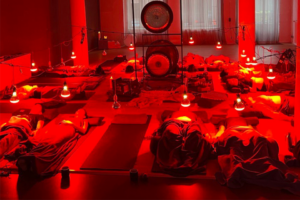Is Red Light Therapy Safe During Pregnancy? A Comprehensive Guide

Red light therapy has gained popularity for its potential health benefits, but many expectant mothers wonder about its safety during pregnancy. This comprehensive guide will explore the use of red light therapy during pregnancy, addressing common concerns and providing evidence-based information to help you make an informed decision.
Table of Contents
What is Red Light Therapy and How Does it Work?
Red light therapy, also known as low-level light therapy (LLLT) or photobiomodulation, is a non-invasive treatment that uses specific wavelengths of light to stimulate cellular function. This therapy typically employs red and near-infrared light wavelengths between 630-850 nanometers to penetrate the skin and underlying tissues.The primary mechanism of action involves the absorption of light by mitochondria, the powerhouses of our cells. This process can enhance energy production, reduce inflammation, and promote healing at the cellular level.
Is Red Light Therapy Safe During Pregnancy?
The safety of red light therapy during pregnancy is a topic of ongoing research and debate. While there is no definitive evidence suggesting that red light therapy is harmful to pregnant women or their developing fetuses, caution is advised due to the limited studies specifically focused on pregnancy.Red light therapy is generally considered safe for most people, including pregnant women, when used properly. However, it’s crucial to consult with your healthcare provider before starting any new treatment during pregnancy.
Potential Benefits of Red Light Therapy for Pregnant Women
Red light therapy may offer several potential benefits for expectant mothers:
- Reduced inflammation: Red light therapy has been shown to reduce inflammation, which could be beneficial for pregnant women experiencing swelling or discomfort.
- Improved skin health: Many women experience skin changes during pregnancy, and red light therapy may help improve skin elasticity and reduce the appearance of stretch marks.
- Pain relief: Some studies suggest that red light therapy can help alleviate back pain and joint discomfort, common issues during pregnancy.
- Enhanced wound healing: For women who have undergone cesarean sections, red light therapy may promote faster healing of surgical incisions.
- Mood improvement: Light therapy has been shown to have positive effects on mood and may help alleviate symptoms of depression during pregnancy.
Are There Any Risks Associated with Red Light Therapy During Pregnancy?
While red light therapy is generally considered safe, there are some potential risks and considerations for pregnant women:
- Overheating: Pregnant women should avoid treatments that significantly raise body temperature. Ensure the red light therapy device doesn’t generate excessive heat.
- Photosensitivity: Some medications can increase sensitivity to light. Consult your healthcare provider if you’re taking any medications during pregnancy.
- Electromagnetic fields: Some red light therapy devices may emit low-level electromagnetic fields. While there’s no evidence of harm, some women may prefer to limit exposure during pregnancy.
- Lack of long-term studies: There is limited research on the long-term effects of red light therapy during pregnancy, which calls for caution.
How to Safely Use Red Light Therapy While Pregnant
If you and your healthcare provider decide that red light therapy is appropriate during your pregnancy, follow these guidelines for safe use:
- Choose a reputable device: Opt for FDA-cleared red light therapy devices from trusted manufacturers.
- Start slowly: Begin with short sessions and gradually increase duration as tolerated.
- Monitor your body: Pay attention to how your body responds and discontinue use if you experience any discomfort or unusual symptoms.
- Avoid sensitive areas: Do not direct the light therapy directly at the abdomen or breasts during pregnancy.
- Maintain proper distance: Follow the manufacturer’s instructions regarding the distance between your body and the device.

Red Light Therapy for Common Pregnancy Concerns
Can Red Light Therapy Help with Pregnancy-Related Skin Issues?
Many women experience skin changes during pregnancy, such as melasma, acne, or stretch marks. Red light therapy may help improve skin health by:
- Stimulating collagen production
- Reducing inflammation
- Improving skin elasticity
While more research is needed specifically for pregnancy-related skin issues, red light therapy has shown promise in improving overall skin health.
Is Red Light Therapy Effective for Pregnancy-Related Back Pain?
Back pain is a common complaint during pregnancy. Some studies suggest that red light therapy may help alleviate musculoskeletal pain. A wearable red light therapy wrap could be a convenient option for targeting back pain, but always consult your healthcare provider before use.
Can Red Light Therapy Improve Sleep Quality During Pregnancy?
Many pregnant women struggle with sleep disturbances. Red light therapy may help improve sleep quality by:
- Regulating circadian rhythms
- Increasing melatonin production
- Reducing inflammation and pain that may interfere with sleep
Consider using a red light therapy device in the evening to potentially improve your sleep quality.
Alternatives to Red Light Therapy During Pregnancy
If you’re hesitant about using red light therapy during pregnancy, consider these alternative therapies that are generally considered safe:
- Prenatal massage: Can help relieve muscle tension and improve circulation.
- Acupuncture: May help with various pregnancy-related discomforts when performed by a qualified practitioner.
- Gentle exercise: Activities like prenatal yoga or swimming can help alleviate pain and improve overall well-being.
- Proper nutrition: A balanced diet can support skin health and reduce inflammation naturally.
When to Avoid Red Light Therapy During Pregnancy
While red light therapy is generally considered safe, there are certain situations where it’s best to avoid this treatment during pregnancy:
- High-risk pregnancies: Women with complicated pregnancies should be extra cautious and consult their healthcare provider.
- Photosensitivity: If you have a condition that makes you sensitive to light, red light therapy may not be suitable.
- Certain medications: Some medications can increase light sensitivity. Always inform your healthcare provider about any treatments you’re considering.
The Future of Red Light Therapy in Prenatal Care
As research in this field continues to evolve, we may see more specific applications of red light therapy in prenatal care. Future studies may focus on:
- Optimizing wavelengths and treatment protocols for pregnancy-related concerns
- Long-term safety assessments for both mother and child
- Potential benefits for postpartum recovery
Conclusion: Making an Informed Decision
Red light therapy offers potential benefits for pregnant women, but it’s essential to approach its use with caution and under professional guidance. Here are the key takeaways:
- Red light therapy is generally considered safe when used properly, but research specific to pregnancy is limited.
- Potential benefits include reduced inflammation, improved skin health, and pain relief.
- Always consult with your healthcare provider before starting red light therapy during pregnancy.
- Use FDA-cleared devices and follow safety guidelines if you choose to use red light therapy.
- Consider alternative therapies if you’re unsure about using red light therapy during pregnancy.
Remember, every pregnancy is unique, and what works for one woman may not be suitable for another. By staying informed and working closely with your healthcare provider, you can make the best decisions for your health and the health of your baby.
A red light therapy device suitable for home use






